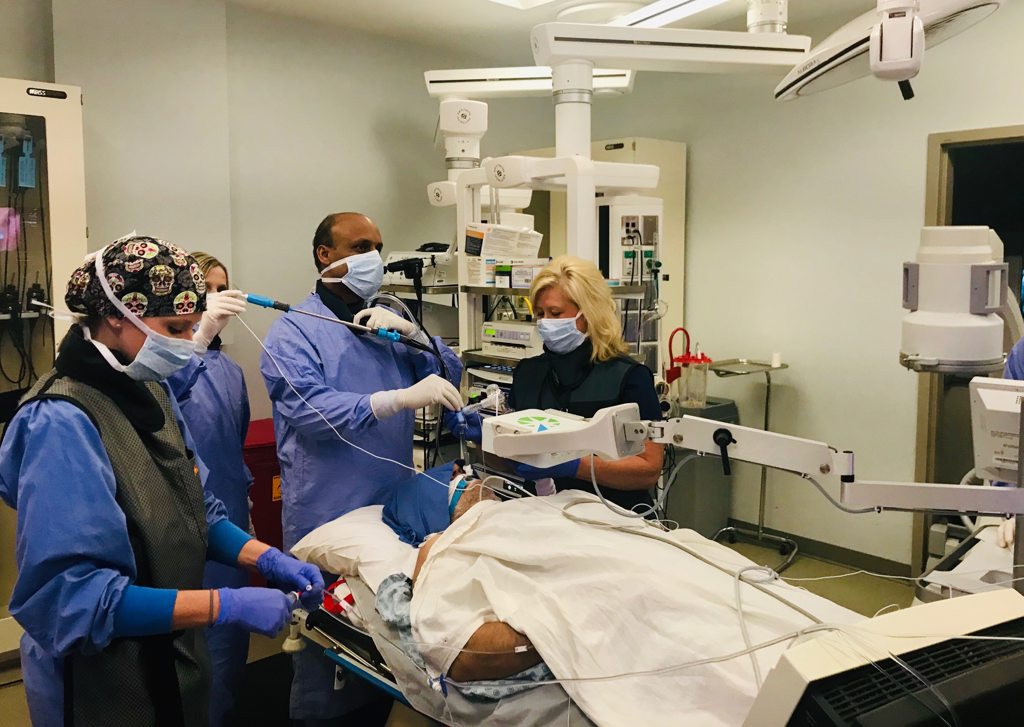
Penn Highlands Healthcare First to Use SPiN Access Catheter to Assist with Lung Cancer Diagnosis
The Lung Center of Penn Highlands Healthcare recently became the first to use a new navigated catheter that will help physicians diagnose and guide treatment of smaller, early-stage lung cancer lesions.
The first ever procedures with the new SPiN Access Catheter™ – a product of Veran Medical Technologies – were completed in October by Dr. Sandeep Bansal, medical director of The Lung Center and Intensive Care Services at Penn Highlands DuBois.
“We are extremely proud to be on the forefront of this new technology that makes early detection and treatment of lung cancer even more likely,” Bansal said. “Our patients deserve the best lung care possible, and we continuously strive to be here for them with the latest innovative and advanced treatment options.”
Physicians are challenged with trying to use traditional bronchoscopy to biopsy small lung nodules, which can be as small as the size of a pea. In addition to their small size, because of the respiratory motion, 46 percent of these nodules move greater than the size of the nodule, according to the medical device company headquartered in St. Louis, MO.
The new navigated catheter allows physicians to utilize a catheter-based approach to sample lung nodules, with the added advantages of a more accurate 3D map for navigation, respiratory gating, and compatibility with Always-On Tip Tracked® sampling instruments. The SPiN Access Catheter™ is currently being utilized in the Bronchoscopy Suite, which is used for diagnosing and treating lung disease, at Penn Highlands DuBois.
According to Bansal, founder and chairman of the Lung Cancer Screening Program at Penn Highlands, lung cancer is the leading cause of cancer-related death among both men and women worldwide. Symptoms of lung cancer are often silent and by the time symptoms are noticeable, the cancer generally has spread to other parts of the body.
"We’ve taken great strides in recent years in the early diagnoses of lung cancer through the addition of low-dose CT screening,” Bansal said. “This new technology will help us to accurately navigate to and access even the smallest of nodules that are identified through lung cancer screening. Ultimately, this will help us to save lives.”
According to Veran, 94 million current or former smokers in the U.S. remain at elevated risk for developing lung cancer. More than 8 million people in the U.S. currently meet the criteria for lung cancer screening.
Bansal recommends those who meet the following criteria should consider annual lung cancer screening:
- Individuals between ages 55 and 80 with at least a 30 pack-year smoking history and continue to smoke or quit smoking less than 15 years ago. One pack-year is equal to smoking 20 cigarettes, or one pack, every day for one year.
- Individuals age 50 or older with at least 20 pack-years and one or more risk factors: long-term exposure to asbestos, asbestos-related lung disease, COPD, pulmonary fibrosis, family history of lung cancer, long-term exposure to silica, cadmium, arsenic, beryllium, chromium, diesel fumes, nickel, coal smoke and soot.

